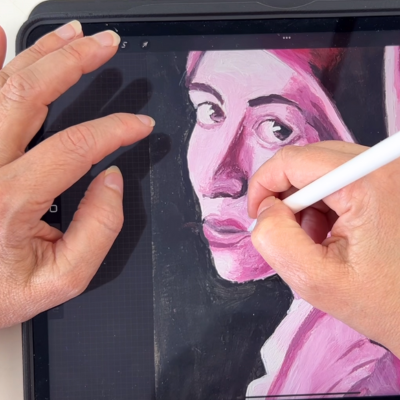5 ways to loosen up your art
“How can I paint more loosely?” is a question I often receive. One of the answers is that you must learn to draw loosely before you can paint loosely. They go hand in hand! In this blog post, I’ll share 5 ways to loosen up your art and explore new creative avenues. Let’s dive in!
Table of Contents
- Tip #1: Be Comfortable with “Wasting” Art Materials
- Tip #2: Choose an Easy Subject
- Tip #3: Embrace Discomfort
- Tip #4: Try Blind Contour Drawing or Non-Dominant Hand Drawing
- Tip #5: Experiment with Different Mediums
- My Garden Art Experiment
- Final Thoughts
Tip #1: Be Comfortable with “Wasting” Art Materials
First things first, you need to be comfortable with the idea of “wasting” art materials. Remember, it’s not genuinely wasting if you’re learning something from the process. However, if you’re working with precious paper or a fancy sketchbook, you might hesitate to experiment and take risks. To overcome this, try using a more affordable sketchbook you are okay with filling with experimental drawings and paintings.
I’m using an A4 sketchbook with 140 gsm of regular drawing paper. This is different from the quality of paper I’m used to, but I’m comfortable with scribbling inside this way. And yes, the paper is buckling and warping with wet mediums, but it’s part of the fun!

Tip #2: Choose an Easy Subject
When you’re trying to loosen up your art, choosing a subject that’s easy to work with is helpful. While you can work on loosening up portraits and figures, starting with something more straightforward is best. Choose a subject that doesn’t move, like plants or still-life objects. This will allow you to focus on loosening your technique without the added challenge of working with a moving subject.
I’m lucky to have a garden with a lot of plants inside. If you don’t, you can use house plants or photos from the internet. Try to vary your reference images on the same topic. It will give more variety to your work and make your art more interesting.

Tip #3: Embrace Discomfort
You must step out of your comfort zone to loosen up your art. This might mean changing your drawing location, using different tools, or even changing how you sit or stand while working, changing your scale, work on smaller or larger papers.
The more you can change, the easier it will be to loosen up your art.

Tip #4: Try Blind Contour Drawing or Non-Dominant Hand Drawing
Blind contour drawing and using your non-dominant hand are excellent ways to loosen up your art. While the results might not be as polished as your usual work, these techniques will help you focus on capturing the essence of your subject without getting bogged down in details.
I usually do this to warm up before a painting session. But I painted on top of those scribbles here, getting interesting results.

Tip #5: Experiment with Different Mediums
Switching up your medium is a fantastic way to loosen up your art. If you typically work with dry mediums, try using wet ones and vice versa. Experiment with different brushes, inks, and unconventional tools like palette knives or sticks.
This is also a good way to use more mediums that may take the dust off some shelves!
The more you experiment, the more you’ll discover new techniques and approaches to help you loosen up your art.

My Garden Art Experiment
I recently spent some time experimenting with different techniques in my garden. I tried various mediums, including gouache, watercolor, ink, and even stamping with leaves and strawberries. The goal was to loosen up my art and discover new ways of approaching my subjects.
After two days of experimenting, I filled my sketchbook with loose, expressive drawings and paintings. I learned that adding brush pens on top of pastels can create interesting textures and that negative painting is a technique I want to explore more.
Final Thoughts
Loosening up your art is all about embracing discomfort, experimenting with new techniques, and allowing yourself to make “messy” art. Remember, it’s not about creating perfect, polished pieces – it’s about learning and growing as an artist. So, which tip resonated with you the most? Happy experimenting!






